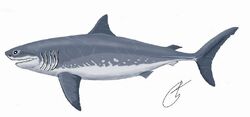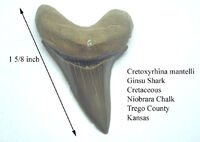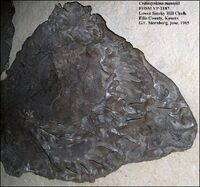| Cretoxyrhina mantelli Fossil range: Late Cretaceous (Cenomanian - Coniacian) | |
|---|---|
 Cretoxyrhina mantelli - "Ginsu shark", from Late Cretaceous of Kansas | |
| Scientific classification
| |
|
Lamniformes | |
|
Cretoxyrhina | |
| |
Cretoxyrhina mantelli (Agassiz 1843) is an extinct species of shark belonging to the family Cretoxyrhinidae. It was one of the largest sharks and a formidable predator in the Late Cretaceous seas, reaching lengths of up to 6.5 to 7 meters (about 22 feet). Nicknamed the Ginsu shark, Cretoxyrhina ripped apart prey with a mouth full of razor-sharp, bone-shearing teeth. Evidence suggests Cretoxyrhina fed on mosasaurs, plesiosaurs, and even the giant bony fish Xiphactinus audax, a fierce predator itself. It survived for about 18 million years, before eventually going extinct due to other rising predators and some other reasons that may have been prey disappearing.
There have been a number of instances where the fossilized remains of mosasaurs are all that remained of some sort of feeding activity. In some cases, there were embedded pieces of teeth from the large lamnid shark, Cretoxyrhina mantelli. In one well documented specimen (FHSM VP-13283), there were embedded Cretoxyrhina teeth, two vertebrae that had been bitten completely through, and the evidence of partial digestion (Shimada, 1997; Everhart, 1999).
Fossils[]

Cretoxyrhina mantelli from the Niobrara Chalk Formation in Trego County, Kansas.

Vertebra from Cretoxyrhina mantelli. 95 mm - almost 4 inches in diameter.
Sharks are made of cartilage, which does not fossilize well. Much of what is known about them comes from their abundant—and harder—teeth. Cretoxyrhina mantelli teeth often grew more than two inches (five centimeters) long. Bite marks and teeth embedded in the bones of its prey suggest Cretoxyrhina chomped with brutal force.

The well preserved remains of a large (5 meter - 16 ft.) Cretoxyrhina mantelli (FHSM VP-2187) is on exhibit in the Sternberg Museum of Natural History in Hays, Kansas. The specimen was collected by G.F. Sternberg in 1965 from the lower Smoky Hill Chalk of Ellis, Kansas.

Close-up of the preserved cranium, jaws and teeth of Cretoxyrhina mantelli.
Most Cretaceous sharks are known primarily from isolated fossilized teeth. In contrast, several nearly complete skeletons of C. mantelli have been discovered. These astonishing fossil finds include disarticulated clusters of vertebrae with associated upper and lower tooth sets lying in clear arcs, giving a vivid impression of Cretoxyrhina's body length and mouth width.
Remarkably, paleontologists have also discovered at least two mineralized impressions of C. mantelli skin, with tooth-like dermal denticles still anchored in place. From these and other, less spectacular finds, it is now known that Cretoxyrhina mantelli lived globally in oceanic and coastal areas, including the Western Interior Seaway (sometimes known by more evocative name, Sundance Sea) which had flooded inland North America during the Mesozoic.
Hundreds of Cretoxyrhina mantelli teeth and vertebra have been collected from Late Cretaceous deposits in the western part of that state, indicating that this species was once quite abundant there. Each of these teeth had a smooth-edged blade and resembled those of a mako, but were much broader and more massive with an unusually thick enameloid coating. Such teeth clearly enabled it to feed on large, active, and well-armed prey.
Teeth[]
Cretoxyrhina mantelli teeth are large and fairly similar to those of the modern-day shortfin mako shark, Isurus oxyrhinchus. A single pair of short, blade-like cusplets may develop on the extreme ends of the crown foot in some lateral and posterior (but not anterior) teeth.
The largest Cretoxyrhina mantelli tooth ever found was 63mm and was collected in stream gravels derived from Coniacian or Santonian Austin Group sediments in Grayson County, Texas.
Distinguishing characteristics[]
The teeth of Cretoxyrhina mantelli are most likely to be confused with those of Cretalamna and Paranomotodon. The abscence of cusplets in anterior teeth distinguishes C. mantelli from Cretalamna.
Kansas[]
In Kansas, Cretoxyrhina mantelli is found in the Carlile Shale (middle Turonian), Fort Hays Limestone (lower through middle Coniacian) and Smoky Hill Chalk (Upper Coniacian through lower Campanian). C. mantelli is the most common shark from the family Cretoxyrhinidae in the Smoky Hill chalk. It is found from the base of the chalk upwards, but becomes extinct during early Campanian time. Cretoxyrhina teeth have not been found in the last few meters of this formation. Studies have shown a general increase in size in Cretoxyrhina teeth through time, but fieldwork by the author indicates that the species reaches its largest size by the end of the Coniacian. In the Smoky Hill chalk, the largest teeth have crown heights in the 52-54 mm range. Welton and Farish (1993) cite a 63 mm Cretoxyrhina tooth from gravels derived from the Coniacian / Santonian Austin group in Texas. The Smoky Hill chalk of Kansas has been the source of several well preserved and nearly intact shark "mummies", with complete dentitions, dermal scales, vertebral columns, stomach contents, and fossilized cartilage. This shark probably reached lengths of 6 meters or more in the Western Interior Seaway during the Late Cretaceous.
Estimates from a few calcified remains of cartilaginous Ginsu sharks suggest they grew upwards of 24 feet (7 meters) long, similar in size to modern great white sharks. Though fierce and feared, Cretoxyrhina was preyed upon by the giant mosasaur Tylosaurus, and C. mantelli remains were scavenged by the smaller shark of its time, Squalicorax. Fossil tooth marks suggest Cretoxyrhina and Squalicorax sharks went after the same food, either hunting together or stealing from each other.
Diet[]

A Cretoxyrhina and two Squalicorax circling around a dead Claosaurus
Several specimens of the Late Cretaceous lamniform shark, Cretoxyrhina mantelli (Agassiz), from the Niobrara Chalk of Kansas suggest that the shark fed on teleosts, mosasaurs, and possibly plesiosaurs. These animals are active vertebrates, so C. mantelli probably occupied the apex of the food chain in the Late Cretaceous seas.
Welton and Farish (1993) stated that "sharks of the Family Cretoxyrhinidae clearly were the largest and voracious of all fish predators in Cretaceous seas." Siverson (1992) speculated that Cretoxyrhina mantelli fed on "large prey like sea turtles, elasmosaurs, small mosasaurs and other sharks."
Although distinguishing predatory or scavenging activity is often difficult in the fossil record, the specimens examined suggest that Cretoxyrhina mantelli ingested at least the following animals: ichthyodectids including the largest form, Xiphactinus audax; mosasaurs; and possibly plesiosaurs.
Xiphactinus and bony fish[]

A photograph of a Cretoxyrhina mantelli disarticulated shark specimen (KUVP 247) at the University of Kansas Museum of Natural History. Inside are the remains of a large Xiphactinus audax inside the shark when it died. Note the large lower jaw, with teeth, in the upper center of this picture. Xiphactinus ribs are also scattered among the shark vertebrae.
A nearly complete skeleton of Cretoxyrhina mantelli, KWP 247, is associated with many bones of Xiphactinus audax (KWP 245), including cranium, jaws, ribs, vertebrae, and some other elements, scattered throughout the matrix. They most likely represent stomach contents of the shark, because all the Xiphactinus bones are located behind the Cretoxyrhina jaw elements, and because some bones overlap the shark vertebrae. The Xiphactinus individual was relatively large.
A very incomplete skeleton of Cretoxyrhina mantelli, KUVP 55060, is another specimen associated with some fragmentary teleost bones. The teleost remains appear to be cranial elements of an ichthyodectid (genus and species indeterminate). The ichthyodectid in this specimen seems to be a smaller individual than the Xiphactinus in KUVP 247.
Mosasaurs[]

The right side of dorsal vertebrae D1 (right) through D4 (left) after preparation. The white arrows mark the location of several Cretoxyrhina bite marks, including the location of the embedded tooth in vertebra D4.
Rothschild and Martin (1993, p. 300-303, figure 21-9) reported a "string of co-ossified caudal vertebrae" of a mosasaur, Clidastes (KUVP 1094), which had suffered infectious spondylitis (Figure 3). They sectioned the specimen and found a shark tooth embedded in the bone, which they identified as Squalicorax, and suggested that the apparent bite caused the pathology of the vertebrae. This is the same specimen as the one figured and discussed previously by Martin and Rothschild (1989, figure 4) as Platecarpus vertebrae bitten probably by Cretalamna. A re-examination of the tooth (suggested by J.D. Stewart) however revealed that no serrations characteristic of Squalicorax are present along the partially exposed cutting edge of the crown. Instead, a clear razor-like cutting edge is present, and the relative tooth size and enameloid thickness suggest that it belongs to Cretoxyrhina, and not to Cretalamna. Cretoxyrhina teeth are more robust than Cretalamna teeth, and the enameloid of Cretoxyrhina is thicker than that of Cretalamna. KUVP 1094 is the only specimen that shows direct evidence of a Cretoxyrhina attack, and subsequent healing and survival of the attacked animal.
Everhart et al. (1995) reported a specimen of five articulated mosasaur vertebrae bitten by Cretoxyrhina recovered from the Smoky Hill Chalk. This mosasaur specimen, a series of dorsal vertebrae from the posterior portion of the rib cage of Platecarpus? (FHSM VP-13283), preserves two embedded Cretoxyrhina tooth tips (FHSM VP-13284 and VP-13285) and at least four tooth marks probably attributable to one shark on the ventral side of the mosasaur vertebrae (Figure 4). This specimen clearly shows a bite direction from the right side of the mosasaur's body, indicated by the labial-lingual directions of the embedded Cretoxyrhina teeth and tooth marks. Whether the Cretoxyrhina attacked or scavenged the mosasaur is uncertain. If it was an attack, however, it must have been a fatal one.
Another mosasaur specimen with embedded Cretoxyrhina teeth was recovered from the Smoky Hill Chalk in western Kansas (M.J. and PA. Everhart collection). The specimen is a Tylosaur? skull in which a few Cretoxyrhina tooth tips are lodged into its jaw elements. The mosasaur bones do not show healing (Shimada, personal observ.), so whether the Cretoxyrhina attacked or scavenged the mosasaur cannot be determined.
Paleobiology[]

This drawing (adapted from Shimada, 1994) shows the arrangement of teeth in the upper and lower jaws of Cretoxyrhina mantelli. The front of the jaw is to the left. This shark had a total of about 80 teeth at the gum line. Each of these teeth had as many as 7 replacement teeth in various stages of growth on the inside of the jaws.
Based on specimens collected from the Smoky Hill Chalk in Kansas, a wealth of paleobiological information regarding Cretoxyrhina mantelli is available. The total body length of a large C. mantelli is estimated to be 4.5 to 5 m (Shimada, 1993a), but very large individuals probably reached slightly over 6 m (Shimada, in press). Its skeletal anatomy suggests that the body form of C. mantelli resembled that of extant white shark (Carcharodon carcharias) (Shimada, in press), and was capable of fast swimming (Shimada, 1994c). The dental and jaw elements of Cretoxyrhina mantelli resemble those of extant mako shark (Isurus) (Shimada, 1993b), so the feeding mechanics of C. mantelli is thought to be similar to that of the mako (Shimada, 1994a, 1997). The similarity of tooth morphology between Isurus and C. mantelli have been considered convergent (Gluckman, 1958; Cappetta, 1987), and increasing knowledge of its dentition and skeletons from the Smoky Hill Chalk of Kansas supports this view (Shimada, 1995, 1997, in press).
Recent Events[]
A recent paper by paleontologist Kenshu Shimada reviewed the paleoecology of Cretoxyrhina mantelli from late Cretaceous deposits in Kansas. According to Shimada, associated fossil remains with evidence of digestive damage suggest that probable fish prey of C. mantelli included the massively jawed, 14-foot (4.25-metre) long Xiphactinus, which resembled a dagger-toothed tarpon and was a powerful predator in its own right. Based on a few tooth-scarred, associated mosasaur vertebrae, Shimada suggests that C. mantelli also tackled these 10- to 40-foot (3- to 12- metre) long marine reptiles of the late Cretaceous.
Stratigraphic occurences[]
Manitoba[]
Texas[]
- Eagle Ford Group
- Tarrant Formation
- Britton Formation
- Austin Group
- Atco Formation
Kansas[]
References[]
- Shimada, K., 1997. Paleoecological relationships of the late Cretaceous lamniform shark, Cretoxyrhina mantelli (Agassiz). Journal of Paleontology 71(5):926-933.
- Shimada, K. 2008. Ontogenetic parameters and life history strategies of the Late Cretaceous lamniform shark, Cretoxyrhina mantelli, based on vertebral growth increments. Journal of Vertebrate Paleontology 28(1):21-33.
- Corrado, C. A., D. A. Wilhelm, K. Shimada, and M. J. Everhart. 2003. A new skeleton of the Late Cretaceous lamniform shark, Cretoxyrhina mantelli, from western Kansas. Journal of Vertebrate Paleontology, Volume 23 (Supplement to Number 3): 43A.
- Everhart, M. J., 1999. Evidence of feeding on mosasaurs by the late Cretaceous lamniform shark, Cretoxyrhina mantelli. Jour. Vert. Paleon. 17(suppl. to 3):43A-44A.
- Meyer, R. L. 1974. Late Cretaceous elasmobranchs from the Mississippi and East Texas embayments of the Gulf Coastal Plain. Unpublished Doctoral dissertation, Southern Methodist University, Dallas, 419 pp.
- Shimada, K., 1997. Stratigraphic record of the Late Cretaceous lamniform shark, Cretoxyrhina mantelli (Agassiz), in Kansas. Kansas Acad. Sci. Trans. 100(3-4):139-149.
- Welton, B. and Farish, R., 1993. The Collector's Guide to Fossil Sharks and Rays from the Cretaceous of Texas. Before Time, Texas. 204 pp.